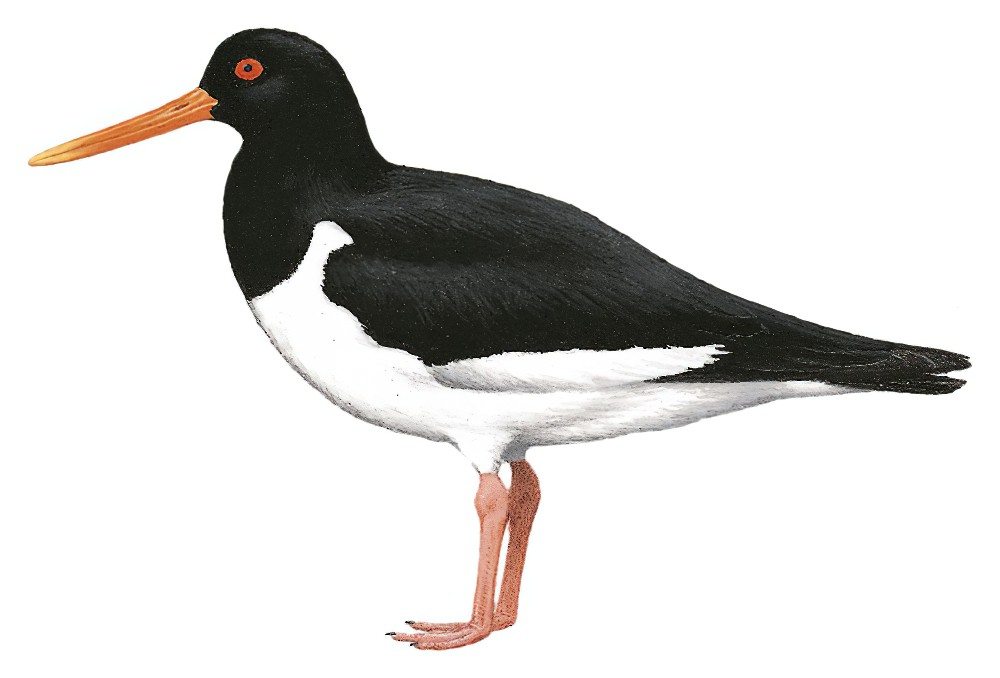Eurasian Oystercatcher / Haematopus ostralegus

Eurasian Oystercatcher
SCI Name:
Protonym: Haematopus Ostralegus Syst.Nat.ed.10 p.152
Taxonomy: Charadriiformes / Haematopodidae / Haematopus
Taxonomy Code: euroys1
Type Locality: Europe and America = Oland, from first reference.
Author: Linnaeus
Publish Year: 1758
IUCN Status: Near Threatened
DEFINITIONS
HAEMATOPUS
(Haematopodidae; Ϯ Eurasian Oystercatcher H. ostralegus) L. haematopus, haematopodis blood-foot < Gr. αἱμα haima, αἱματος haimatos blood; πους pous, ποδος podos foot; "81. HÆMATOPUS. Rostrum compressum: apice cuneo æquali. Pedes tridactyli, fissi." (Linnaeus 1758): ex "Haematopus" of Belon 1555, Aldrovandus 1599-1603, Linnaeus 1745, and Linnaeus 1746, and "Sea-Pie" of Willughby 1676, Ray 1713, and Albin 1731-1738; "Hæmatopus Linné, Syst. Nat., ed. 10, 1, 1758, p. 152. Type, by monotypy, Haematopus ostralegus Linné." (Peters, 1934, II, p. 231). Linnaeus's Haematopus comprised a single species.
Var. Himatopus, Hoematopus, Haemantopus, Haemotopus.
Synon. Melanibyx, Ostralega, Ostralegus, Palostralegus, Prohaematopus.
haematopus
L. haematopus, haematopodis blood-foot < Gr. αἱμα haima, αἱματος haimatos blood; πους pous, ποδος podos foot.
ostralegus
L. ostrea oyster < Gr. οστρεον ostreon oyster; legere to gather.
● "81. HÆMATOPUS. ... Ostralegus. 1. HÆMATOPUS. It. œl. 83. Fn. svec. 161. Bell. av. 18. Aldr. orn. l. 20. c.31. Will. orn. 220. t. 56. Raj. av. 105. Alb. av. I. p. 74. t. 78. Catesb. car. I. p. 85. t. 85. Habitat in Europæ, Americæ septentrionalis littoribus marinis; victitat conchis." (Linnaeus 1758) (Haematopus).
Ostralegus
(syn. Haematopus Ϯ Eurasian Oystercatcher H. ostralegus) L. ostrea oyster < Gr. οστρεον ostreon oyster; legere to gather (cf. specific name Haematopus ostralegus Linnaeus, 1758); "GENUS XCIII. OSTRALEGUS. OYSTER-CATCHER. The species of this genus, four or five in number, are nearly equal in size, and although much larger, greatly resemble the Turnstone in form as well as habits. ... Ostralegus, although translated Oyster-catcher, ought to be Englished by Shell-gatherer; nor is there the slightest reason to believe that these birds eat oysters. ... 175. OSTRALEGUS HÆMATOPUS. PIED OYSTER-CATCHER" (Macgillivray 1842).
SUBSPECIES
Eurasian Oystercatcher (Western)
SCI Name: Haematopus ostralegus ostralegus/longipes
HAEMATOPUS
(Haematopodidae; Ϯ Eurasian Oystercatcher H. ostralegus) L. haematopus, haematopodis blood-foot < Gr. αἱμα haima, αἱματος haimatos blood; πους pous, ποδος podos foot; "81. HÆMATOPUS. Rostrum compressum: apice cuneo æquali. Pedes tridactyli, fissi." (Linnaeus 1758): ex "Haematopus" of Belon 1555, Aldrovandus 1599-1603, Linnaeus 1745, and Linnaeus 1746, and "Sea-Pie" of Willughby 1676, Ray 1713, and Albin 1731-1738; "Hæmatopus Linné, Syst. Nat., ed. 10, 1, 1758, p. 152. Type, by monotypy, Haematopus ostralegus Linné." (Peters, 1934, II, p. 231). Linnaeus's Haematopus comprised a single species.
Var. Himatopus, Hoematopus, Haemantopus, Haemotopus.
Synon. Melanibyx, Ostralega, Ostralegus, Palostralegus, Prohaematopus.
Eurasian Oystercatcher (Far Eastern)
SCI Name: Haematopus ostralegus osculans
osculans
L. osculans, osculantis kissing (i.e. close together, almost united, allied) < osculari to adhere closely, to kiss < osculum kiss < dim. os, oris mouth (cf. oscillans, oscillantis swinging < oscillare to swing).
● “CHALCITES OSCULANS. ... I have applied the term of osculans to this species, because in it are united to a remarkable degree the characters of the genera Cuculus and Chalcites; but as those of the latter genus predominate, I have retained it therein.” (Gould 1847) (Chalcites).
● "HELIANTHEA OSCULANS, Gould. ... This new species is about the same size as H. violifera, but differs from that bird in having a stouter and longer bill, by the spot on the forehead being larger, and green instead of blue; by the tips of the tail-coverts and tail-feathers being tinged with olive-green, and by the breast being of a more brilliant green, and destitute of any crescentic greyish-white mark across the chest." (Gould 1871) (Coeligena).
● "RAMPHASTOS OSCULANS. ... Ramph. culminato, Gould, quam proxime accedit." (Gould 1835) (syn. Ramphastos vitellinus x R. cuminatus).
● "SERICORNIS OSCULANS, Gould. ... Intermediate in size between S. frontalis and S. humilis."(Gould 1847) (syn. Sericornis frontalis mellori x S. f. rosinae).
UPPERCASE: current genus
Uppercase first letter: generic synonym
● and ● See: generic homonyms
lowercase: species and subspecies
●: early names, variants, mispellings
‡: extinct
†: type species
Gr.: ancient Greek
L.: Latin
<: derived from
syn: synonym of
/: separates historical and modern geographic names
ex: based on
TL: type locality
OD: original diagnosis (genus) or original description (species)












